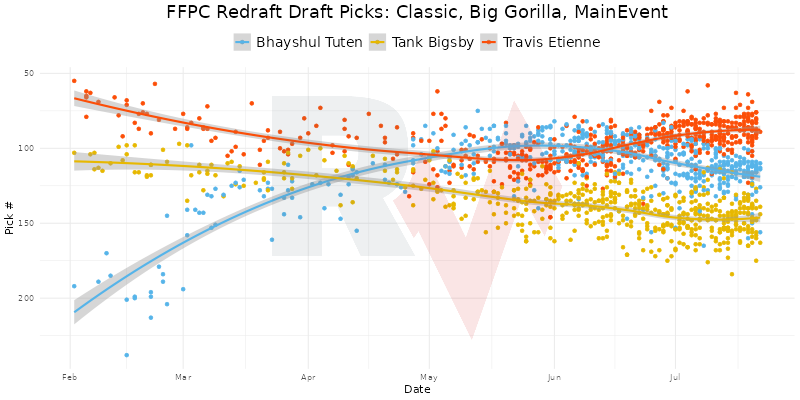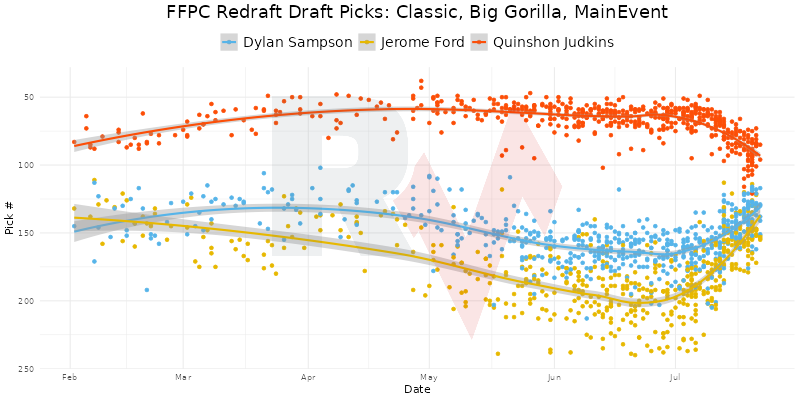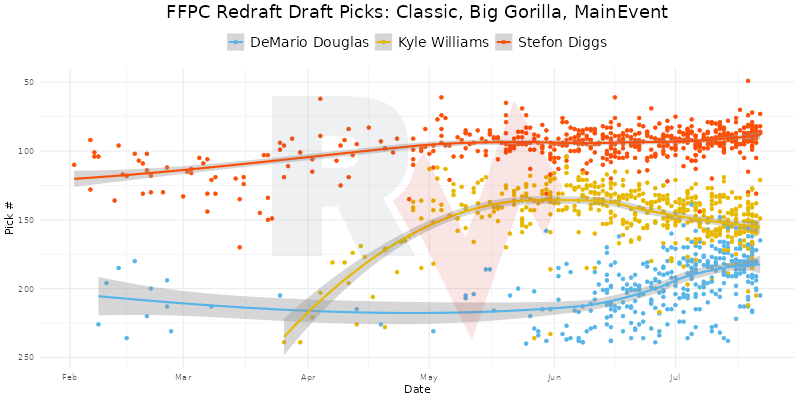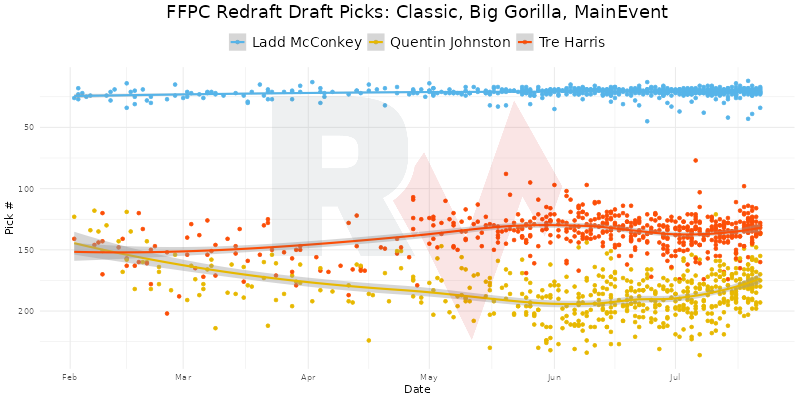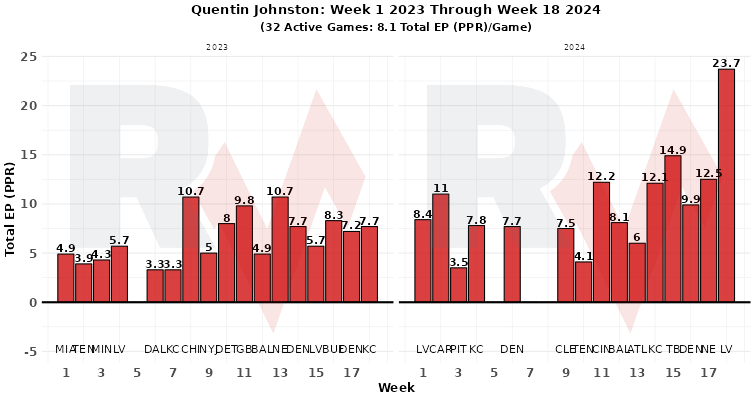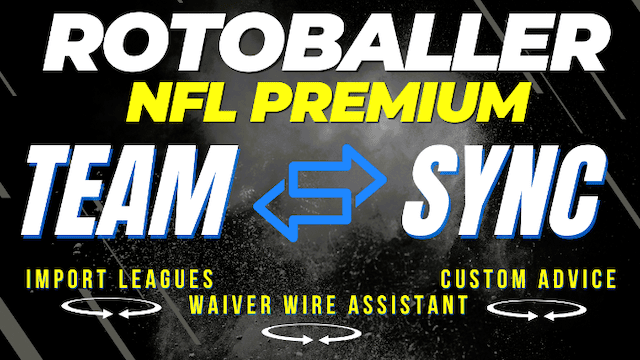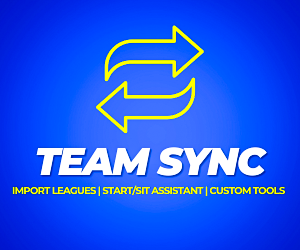Corbin's examines five rookies to target in dynasty that we might want avoid in redraft leagues. These rookies are overvalued in 2025 redraft leagues but have value in dynasty leagues
This is a tricky process because we typically want to build our redraft teams like dynasty ones. After all, rookies and young players impact fantasy squads. One way to filter through which players to examine involves looking at the differences between the Fantasy Football Players Championship (FFPC) Average Draft Position (ADP) in redraft and one-quarterback dynasty leagues. One starting point includes players with a 25-pick difference in their redraft versus dynasty ADP. The visual below shows the players with a lower redraft ADP by 25 picks or more compared to their dynasty prices.
Like anything, one stat filter shouldn't mean the analysis ends. However, any stat filter allows us to dive deeper into the market and the player's situation. That said, we'll examine five rookies who might be targets in dynasty leagues, though we have some reasons to fade in redraft leagues. Throughout the offseason, the rookie data consumes us, so there might be some overanalysis.
Be sure to check all of our fantasy football rankings for 2025:- 2025 fantasy football rankings
- Running back (RB) fantasy football rankings
- Wide receiver (WR) fantasy football rankings
- Tight end (TE) fantasy football rankings
- Quarterback (QB) fantasy football rankings
- FLEX fantasy football rankings
- Defense (D/ST) fantasy football rankings
- Kicker (K) fantasy football rankings
- Dynasty fantasy football rankings
After analyzing the rookie profiles, team-level situations, and summarizing how they fit into their offenses in 2025, we'll provide quick takeaways on reasons why to fade or target them in their respective formats. It's a beefy one, so let's dig into the data and explore it.
Bhayshul Tuten, RB, Jacksonville Jaguars
Dynasty 1-QB ADP: 81.9
Redraft ADP: 115.2
The only team with three running backs drafted in ADP within the top 150 picks is the Jaguars. Tuten goes behind Travis Etienne and ahead of Tank Bigsby. It's unusual to have three running backs going inside the top 150, hinting at the redraft market being mostly confused about this backfield.
Tuten was arguably one of the most explosive and electric running backs in the 2025 class. That's evident by Tuten's 81 percent career Running Back Dominator (No. 1) and 10 percent career receiving yardage market share (No. 3) in the class. He forced a missed tackle on 36.3 percent of his attempts (No. 3) in his career and 46.6 percent of his carries going for 15 or more yards (No. 5).
After Etienne dominated the backfield workload in 2023, with a 74 percent snap share, 59 percent team rush percentage, and a 12 percent target share, the usage evened out in 2024. Etienne dealt with a shoulder and hamstring injury early in the 2024 season. After Etienne's injuries cropped up in Weeks 5-18, the usage shifted with Bigsby garnering a higher rushing workload.
Tuten arguably has more athleticism and explosiveness than Bigsby, as Tuten boasts an elite Speed (96th percentile) and Explosion Scores (98th percentile). The rookie could take rushing and receiving opportunities from Etienne and Bigsby. However, Etienne and Bigsby probably have priority for touches early in the 2025 season.
The Buccaneers used three running backs, including Rachaad White, Bucky Irving, and Sean Tucker. However, White and Irving handled most of the workload. With Liam Coen as the offensive coordinator with the Rams in 2022, they used Cam Akers, Darrell Henderson Jr., and Kyren Williams sparingly. Akers led the team in rush share (53 percent), with Henderson and Williams each garnering a six percent target share.
For context, the 2022 season was a down year for the Rams with Matthew Stafford and Cooper Kupp missing time, meaning Tyler Higbee led the team in targets (108).
Summary
Etienne remains a fade in this backfield unless we see him healthy and bouncing back to a heavier workload. Logic tells us Etienne garners some rush and receives work like White with the Tampa Bay. Bigsby doesn't profile like Irving because Bigsby lacks the receiving profile. The dynasty market has shown much more excitement about Tuten than in redraft leagues.
However, Tuten should arguably be going closer to his dynasty ADP because of the Irving-type profile, where he can be an efficient rusher and receiver. The difference between Tuten involves the elite athleticism. We'll disagree with the dynasty and redraft market here because Tuten possesses high-end upside.
Quick Reasons to Target in Dynasty: Uncertainty with three running backs, an explosive athlete, and strong collegiate production.
Quick Reasons to Avoid in Redraft: Tuten possesses a ton of upside, so don't avoid him.
Quinshon Judkins, RB, Cleveland Browns
Dynasty 1-QB ADP: 38.7
Redraft ADP: 73.7
The sample of ADP data would be too small to examine the market value for Judkins before and after the recent arrest news. Furthermore, Judkins hasn't signed a contract with the team because some of the second-round picks have requested guaranteed money. Judkins goes in the historical running back dead zone, with his teammates Dylan Sampson and Jerome Ford going past pick 150.
Judkins had an awful three percent receiving yardage market share in his career, ranking 34th out of 38 running backs in the 2025 class on the spreadsheet. He profiles as an early-down grinder and a touchdown-scoring machine, with 45 rushing touchdowns, accounting for a 57 percent adjusted rushing touchdown market share in his career.
Judkins had close comparisons to Eddie Lacy, T.J. Yeldon, Akers, Mark Ingram II, Jeremy Hill, and David Montgomery. Ingram and Montgomery had the most extensive careers. The others were somewhat limited as one-year wonders for various reasons.
The Browns sneakily ranked 11th in adjusted yards before contact per attempt and 10th in pass rate over expected. That indicates the Browns had above-average run blocking while being pass-heavy in neutral game scripts. For context, the Browns' defense ranked 26th in success rate and 30th in explosive play percentage, indicating they often played from behind.
Summary
Unless Judkins turns into Nick Chubb as an efficient rushing and touchdown scoring machine, there's a narrow path for the rookie to find success in 2025. Ford showed us he could handle most of the team's workload when he took over for Chubb in 2023. Ford had a 52 percent snap share, 39 percent rush percentage, and an 11 percent target share in 2023. Kareem Hunt trailed Ford in all categories.
Ford's usage was similar in 2024 before Chubb returned from his injury, evidenced by his 58 percent snap share, 37 percent team rush percentage, and 12 percent target share. Even when Chubb returned, Ford shared snaps (52 percent) with Chubb (41 percent) from Weeks 7-18 in 2024. Sampson exploded in his final college season at Tennessee with Jaylen Wright gone, leading to a career-best 72 percent RB Dom for Sampson.
We should be making bets on Ford and Sampson over Judkins in 2025.
Quick Reasons to Target in Dynasty: A productive rusher with solid comps, with a possible slight discount with the legal news.
Quick Reasons to Avoid in Redraft: Judkins might lose receiving work to Ford or Sampson, and the Browns trusted Ford in two previous seasons at a discounted price. Take the bet on Sampson and Ford later in drafts.
Kyle Williams, WR, New England Patriots
Dynasty 1-QB ADP: 113.8
Redraft ADP: 151.8
The collegiate production for Williams popped on the spreadsheet, ranking as the WR6 because of his seventh-best receiving yards per team pass attempt (RecYPTA) and third-highest yards per route run against man coverages in 2024. We saw Williams's pre-draft capital skyrocket, going from undrafted early in the offseason to late Day 2, then to the middle of Day 2.
After Diggs suffered a season-ending knee injury last season, he signed a three-year deal with the Patriots this offseason. That move was an attempt to find a WR1 for Drake Maye after Hunter Henry (97), DeMario Douglas (87), Kayshon Boutte (68), and Austin Hooper (59) led the team in targets in 2024. From 2020 to 2023, Diggs earned an elite 28 percent target share (No. 3) behind Davante Adams (33 percent) and Puka Nacua (29 percent).
Diggs tied with A.J. Brown, Justin Jefferson, Tyreek Hill, and Kupp in target share from 2020 to 2023.
The Patriots made a concerted effort to add offensive weapons in the offseason, including Mack Hollins, Williams, TreVeyon Henderson, and Efton Chism III. That's notable because the Patriots ranked first in pass rate over expected, indicating they were leaning into the pass. However, their offensive line needs work because they ranked last in adjusted yards before contact per attempt, with the highest pressure rate allowed.
That's not a fruitful combination for run blocking and pass protection.
They made several investments in the offensive line, including first-round tackle Will Campbell and third-round center Jared Wilson. The Patriots also added Garrett Bradbury (center) and Morgan Moses (right tackle) as their starters, plus some additional depth pieces. Theoretically, that should help the Patriots' offense improve from the 29th-ranked team in EPA per dropback.
Williams was most productive in his fifth collegiate season. Using draft capital and college production, he had some concerning comparisons. T.Y. Hilton and Sterling Shepard were the best comps, though Denzel Mims, Bryan Edwards, and others might hint at Williams being overrated. Williams does have straight-line speed, with a 4.40 40-yard dash, translating into an above-average Speed Score (68th percentile).
In college, Williams saw most of his targets in the short area of the field (0-9 yards), accounting for 44.6 percent of his receiving opportunities. However, Williams still garnered a respectable 23.8 percent target percentage on deep throws (20+ yards).
Summary
So why should the redraft market be fading Williams if the offense takes a step forward? That's a good question, but it's more related to the market discounting Patriots' pass catchers beyond Diggs. Hollins might begin the season as their WR3 behind Diggs and Douglas, but Williams should be able to overtake Hollins. That's especially notable because Hollins has been somewhat of a decoy, with a 58.5 route percentage and a low 14 percent target rate.
It might be worth taking a shot on Williams as a WR6 or WR7 in best ball leagues. However, the dynasty market will typically value rookies higher in their rookie season, so the redraft ADP difference is understandable.
Quick Reasons to Target in Dynasty: Diggs being a trade candidate in the middle of the season if the team struggles, plus some murkiness on the team's top target earner beyond Douglas as their slot receiver.
Quick Reasons to Avoid in Redraft: The mediocre prospect profile for Williams, team-level concerns, and a low upside stash if he hits.
Matthew Golden, WR, Green Bay Packers
Dynasty 1-QB ADP: 65.7
Redraft ADP: 102.8
The Packers added two receivers in the NFL draft, including Golden and Savion Williams. Golden wasn't the most impressive collegiate producer, averaging 1.52 career receiving yards per team pass attempt, ranking 38th out of the 56 rookie receivers on the spreadsheet. The Packers had the lowest neutral game script pass rate (47 percent), indicating they were run-heavy on offense and feeding Josh Jacobs.
Jordan Love and the Packers distributed the ball around, with five pass catchers having a target share of 10 percent or higher. That list includes Tucker Kraft (15 percent), Jayden Reed (16 percent), Romeo Doubs (20 percent), Dontayvion Wicks (16 percent), and Christian Watson (13 percent). That's similar to the receiving usage in 2023, with Reed and Watson at 18 percent, with Doubs (17 percent) leading the team in target shares.
If Golden wasn't a strong target earner in college, it's unlikely that he will garner a high target rate as a rookie with similar personnel, plus the two rookies. Watson suffered a torn ACL in Week 18 last year, so there's a good chance Golden slides into immediate routes and opportunities to begin the 2025 season.
It's reasonable to wonder if Golden can burst onto the scene like Watson's rookie year, when he posted four-straight games as a WR1, averaging 24.8 PPR/G. Watson was the 12th-most efficient receiver as a rookie, given his seven touchdowns on 41 receptions, meaning he averaged 2.8 fantasy points over expected per game.
It's hard to ignore Golden's draft capital and speed because typically first-round receivers fare well in fantasy.
Golden's top comparisons show a wide range of outcomes from Phillip Dorsett to Ladd McConkey. McConkey was more efficient from a yards-per-route standpoint, which Golden lacked. Some others might be far-fetched, like Garrett Wilson and Jefferson. That's mainly because Wilson and Jefferson were much better producers in college from a team market share perspective.
As a prospect, Golden struggled against man coverage, with the sixth-lowest yards per route run at 0.92. Isaac TeSlaa and Golden were the only two receiver prospects who had a 25 percent target rate on deep passes and a 30 percent target share on medium and short area opportunities. That suggests Golden can be a weapon all over the field.
Summary
The downside scenario for Golden involves him not being a high-end target earner, meaning the Packers continue to prefer distributing targets between three to four pass catchers around 15-20 percent of the time. Jameson Williams, Reed, Rashod Bateman, Alec Pierce, Jalen McMillan, and Doubs were the most notable receivers, averaging 10 or more PPR/G with a 15-20 percent target share in 2024.
If fantasy managers are fine with those outcomes, then take Golden at his price.
There have been rumors about the Packers shifting to a more pass-heavy offense, especially with their receiving additions. Golden's path for fantasy relevance consistently seems murky because he'll need multiple pass catchers to struggle, and the team to shift more toward the pass to account for the low team-level volume. Maybe Golden turns into an outlier because first-round receivers tend to be solid bets.
Quick Reasons to Target in Dynasty: Golden is a first-round rookie receiver on a team without an elite target earner, but the receiving opportunities exist.
Quick Reasons to Avoid in Redraft: The Packers' top pass catchers had a 15-20 percent target share over the past two seasons, making it a murky group of pass catchers. Plus, Golden's prospect profile seems to have more reasons for concern than optimism.
Tre Harris, WR, Los Angeles Chargers
Dynasty 1-QB ADP: 87.8
Redraft ADP: 136
It might seem like we're talking out of both sides of our mouths because Harris broke the yards per route run scales, making him a rookie sleeper. Unsurprisingly, Harris has been valued higher in dynasty formats because of his explosive collegiate résumé. The Chargers ranked ninth in explosive pass rate, meaning they attempted 10.6 percent of their passes for 20 or more yards.
Harris had a respectable 21.1 percent of his targets 20 or more yards downfield, generating the fifth-most yards per route run on deep targets. The Chargers have been searching for a deep-threat, with Josh Palmer leading the team with a 26.2 percent deep target rate, with Quentin Johnston (22 percent) and Ladd McConkey (eight percent) behind him.
Speaking of Johnston, he improved in Year 2 by garnering more target volume, with a 24 percent target per route rate and 24.4 percent first-read target share. Johnston tied McConkey in target rate, with McConkey edging him in first-read target share (29.1 percent). Toward the end of the season in Weeks 14-18, Johnston took off, ranking 23rd in fantasy points and expected fantasy points per game.
That indicates Johnston's usage aligned with his production as a WR2.
For context, McConkey produced 19.4 PPR/G and 13.4 expected fantasy points per game in Weeks 14-18. McConkey was an uber-efficient producer, ranking 11th in yards per target over expected on the season. That's notable because Johnston could build upon his late-season surge, while McConkey moves into the WR1 territory on a team that ranked 27th in pass rate over expected, suggesting they prefer to be run-heavy.
Summary
Johnston goes 40-45 picks past Harris, though their ADPs should be closer. There's a chance Harris slides into the Joshua Palmer role, running routes out wide while mixing into the slot. Last season, Palmer had a 15.6 average target depth, yet a lowly 17 percent target rate. Harris broke out late as an older prospect, leading to underwhelming close comparisons.
That list includes Terrance Williams, James Washington, and Bryan Edwards.
Be careful investing in Harris at his price in redraft leagues, especially because Johnston should build upon his Year 2 season. There's a chance that Johnston flops and doesn't meet expectations, but Johnston's redraft price is more enticing because of the small miss, big hit type scenario. If Harris's prospect profile was near-elite like Luther Burden III, who goes within five picks in redraft ADP, then we could have more confidence in Harris in Year 1.
Quick Reasons to Target in Dynasty: Harris was productive against man and zone coverages, with an efficient profile that can produce all over the field.
Quick Reasons to Avoid in Redraft: At best, Harris might be third or fourth in targets on the Chargers, and the redraft price might be too rich, especially since Johnston showed positive signs in Year 2.
More Rookies Fantasy Football Analysis
Download Our Free News & Alerts Mobile App
Like what you see? Download our updated fantasy football app for iPhone and Android with 24x7 player news, injury alerts, rankings, starts/sits & more. All free!






 RADIO
RADIO









